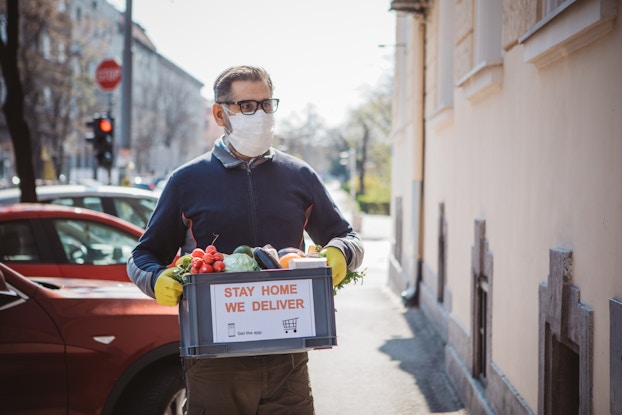
Why it matters:
- Consumers increasingly rely on friends and digital channels to learn and buy, rather than traditional information sources.
- They are seeking the best value for products and services as overall consumption decreases.
- Technology enables all purchases from grocery items to new homes.
The COVID-19 crisis ushered in new norms for everything. In the space of 12 months, people have adopted pandemic parlance from Zooming to social distancing, and the ripple effects of living remote have run through every industry from apparel to hospitality to real estate. Along the way, consumer behaviors changed, potentially for good.

Interested in a small business membership?
Find out how the U.S. Chamber of Commerce can help your company grow and thrive in today's rapidly-evolving business environment. Connect with our team to learn how a small business membership can benefit your bottom line and help you achieve your goals.
All age groups adopt a ‘millennial mindset’ around digital consumption
“During lockdown, the home has become a multiverse. It’s where we work, eat, play, and connect with our families and friends,” the authors of a McKinsey report wrote. They found that during months of social isolation, consumers were spending more time doing home improvements and creating their own entertainment when live events, concerts and movie theaters were verboten.
The
report revealed that 45% of consumers tapped online streaming
services to watch films and TV shows, and turned to replicating
restaurants and concession stand experiences at home.
The National Confectioners Association (NCA) reports that consumption of premium chocolate, for one, has especially benefited, rising 12.5% since last March, as consumer spending on food and beverages rose 10% overall, according to Unity Marketing. Those increases come amid a 17% rise in online shopping across categories, McKinsey found.
The
end of the pandemic may eventually mean a shift away from consuming
movies and meals at home, but consumer spending patterns could be
permanent. “All age groups have begun to adopt a ‘millennial
mindset,’”
according to economists and analysts at the Swiss Re Institute.
“They rely on friends and digital channels to learn and buy, rather
than traditional information sources,” the report’s authors
wrote.
[Read here about tools to manage user generated content.]
During lockdown, the home has become a multiverse. It’s where we work, eat, play, and connect with our families and friends.Victor Fabius, Sajal Kohli, Björn Timelin, and Sofia Moulvad Verane, McKinsey & Company
Ongoing concern with value cuts out the middleman
The
rise of remote work had a far-reaching impact on spending as
purchases of everything from clothing (which changed from business
formal and casual to athleisure)
to toilet paper
(a pandemic-era treasured commodity) reflected new lifestyle
patterns.
NielsenIQ revealed that 80% of shoppers were looking to buy directly from manufacturers, and 71% are still willing to pay more for higher quality fare.
Alison
Lock, the director of NielsenIQ Intelligence Unit, told CO— that
this trend was driven by a perception of value on the part of
consumers. "The majority of consumers believe that by buying directly from manufacturers
and effectively cutting out the 'middleman,' they will get better value through pricing and promotions, greater variety of choice and better rewards," she said. Of the nearly 75% of consumers who say they are
willing to pay more for higher quality products, Lock noted, “they
are willing to make a conscious trade-off on price for a product they
believe will better meet their household needs.”
[More
here
for expert business predictions on pandemic trends that are here to
stay.]
Technology enables big-ticket purchases
Stay-at-home orders and remote work created a perfect storm for people to move to a different dwelling. Census data indicates that sales of new homes increased steadily in the second half of 2020 to 12.3% and continues trending upward this year.
Health concerns and social distancing meant that the traditional walk-through of a model home or viewing an existing property got pushed to platforms like Zoom, FaceTime or Skype. Yet Builders Digital Experience (BDX) surveyed more than 8,000 current home shoppers and recent buyers in 43 housing markets and found that 87% of shoppers run into roadblocks like a lack of details about features or pricing.
“As
the scale of the pandemic became clear, builders pivoted, deploying a
decade of digital transformation in six months,” said Jay McKenzie,
a senior director at BDX. McKenzie told CO— that the company
upgraded its 20-year-old site NewHomeSource.com. The upgrades and
software releases were aimed at “enabling consumers to shop for,
design and buy their new home from the comfort of their couch in
their current home,” according to McKenzie. Additionally, a report
from real estate site Redfin
found that 63% of 1,900 recent homebuyers admitted they purchased
just from viewing online when the listing detailed features and other
specifics necessary to make such a major decision.
“Increased use of digital tools is blurring the lines between work, lifestyle and social interaction and between domains like mobility, health and finance,” Mahesh H. Puttaiah, senior economist at Swiss Re Institute, wrote in the report. “We expect this to continue in the post-COVID-19 world.”
CO— aims to bring you inspiration from leading respected experts. However, before making any business decision, you should consult a professional who can advise you based on your individual situation.
Follow us on Instagram for more expert tips & business owners stories.
CO—is committed to helping you start, run and grow your small business. Learn more about the benefits of small business membership in the U.S. Chamber of Commerce, here.







